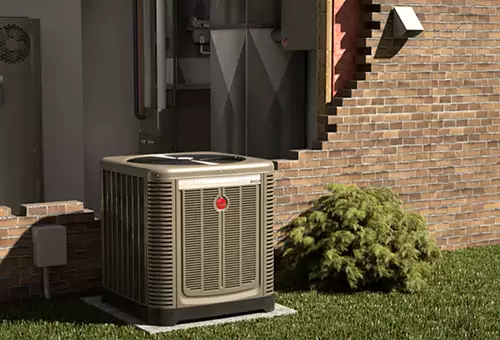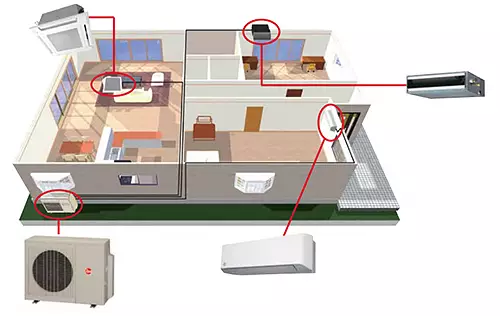All About Heat Pump Technology
If you’re serious about having an efficient home, you’ve probably heard the term heat pump mentioned by your builder or HVAC contractor, or perhaps you’ve come across it in your own research. This highly effective technology can heat and cool, and it does so more efficiently than regular furnace and air conditioning units!
So, what exactly is a heat pump? In contrast to a furnace that burns fuel to warm up a home, a heat pump uses a small amount of energy to transfer heat from one place to another, i.e., from the exterior to the interior, or vice versa. This process is similar to how air conditioning works, but it’s reversible so you can heat in the winter and cool in the summer.
A whole-house heat pump looks similar to an air conditioner from the outside. This unit is where heat is transferred; refrigerant lines connect to the interior coils and blower fan behind the wall to complete the system's loop and exchange heat between indoors and out.
Heat pumps can be air-source or ground-source—that is, they use the air or ground outside as a source of heat. Air-source heat pumps are preferred for residential use because they are much easier to install. You can find plenty of whole-house as well as mini-split systems; if your home has duct work for central HVAC, a whole-house system will offer much the same experience, but mini-splits are ideal for homes that need ductless installation, and they also allow for room-by-room climate control. In either case, the heat pump uses fans, refrigerator coils, a compressor, and a reversing valve to transfer heat.
To bring heat inside, a fan draws outside air over refrigerator coils so they can absorb heat. Even if it’s cold outside, the outside air has a higher temperature than the refrigerant; this temperature differential is what allows the heat pump to gather so much heat where you might assume there is none. When the refrigerant is heated, it changes from a liquid to a gas state, and then the compressor increases the pressure of that gas to increase the temperature even more. This hot, gaseous refrigerant goes through an interior coil by another fan at this point, where it releases its heat to indoor air and returns to a cooler liquid state. Then it goes back through the cycle again!
it’s cold outside, the outside air has a higher temperature than the refrigerant; this temperature differential is what allows the heat pump to gather so much heat where you might assume there is none. When the refrigerant is heated, it changes from a liquid to a gas state, and then the compressor increases the pressure of that gas to increase the temperature even more. This hot, gaseous refrigerant goes through an interior coil by another fan at this point, where it releases its heat to indoor air and returns to a cooler liquid state. Then it goes back through the cycle again!
Need cool air instead? The reversing valve changes the flow of the refrigerant, so it absorbs the heat inside and releases it outside. This process sounds pretty simple when you break it down like this, but take one look inside and you’ll find that heat pumps are incredibly complex. Of course, you’ll also find a lot of variability on the market, so it’s important to explore the options to find the best fit.
The most efficient heat pumps are those with variable speed compressors. Simply put, this allows them to run more consistently and transfer exactly as much heat as you need in the moment. This allows for more precise temperature control and prevents harsh on/off cycles. Not only is this more comfortable for you, but it also saves energy.
Mini-split systems don't require ducts, so they're perfect for tiny homes and old renovations. In this case, an outdoor unit connects to a variety of different indoor units. Each is independently operable for room-by-room climate customization.
Heat pumps come with two main ratings: SEER and HSPF. The SEER (seasonal energy efficiency rating) is a ratio that describes cooling efficiency while the HSPF (heating seasonal performance factor) describes heating efficiency. Both ratings are defined by how much heat (in BTUs) is moved over how much electricity (in watts) is used. A good SEER falls between 14 and 18 while a good HSPF is somewhere in the 8 to 10 range. The higher these numbers, the better, so be on the lookout for even higher ratings!
Whether you need a whole-house solution or a mini-split system that focuses on smaller zones, Rheem® has heat pump options that’ll greatly improve your home’s heating and cooling efficiency. In fact, their Prestige® models are up to 54% more efficient than regular cooling and up to 58% more efficient than heating with a furnace, with SEER ratings over 20 and HSPF ratings over 11. They boast a variable speed compressor and an overdrive feature that maintains a home's comfort when outside temperatures are as high as 107°F and are capable of meeting a home's heating load down to about 0°F. That’s much higher performance than heat pumps of the past, so make sure to explore today's highly efficient possibilities and expect to save hundreds of dollars per year!



.png)
.png)

 it’s cold outside, the outside air has a higher temperature than the refrigerant; this temperature differential is what allows the heat pump to gather so much heat where you might assume there is none. When the refrigerant is heated, it changes from a liquid to a gas state, and then the compressor increases the pressure of that gas to increase the temperature even more. This hot, gaseous refrigerant goes through an interior coil by another fan at this point, where it releases its heat to indoor air and returns to a cooler liquid state. Then it goes back through the cycle again!
it’s cold outside, the outside air has a higher temperature than the refrigerant; this temperature differential is what allows the heat pump to gather so much heat where you might assume there is none. When the refrigerant is heated, it changes from a liquid to a gas state, and then the compressor increases the pressure of that gas to increase the temperature even more. This hot, gaseous refrigerant goes through an interior coil by another fan at this point, where it releases its heat to indoor air and returns to a cooler liquid state. Then it goes back through the cycle again! 

